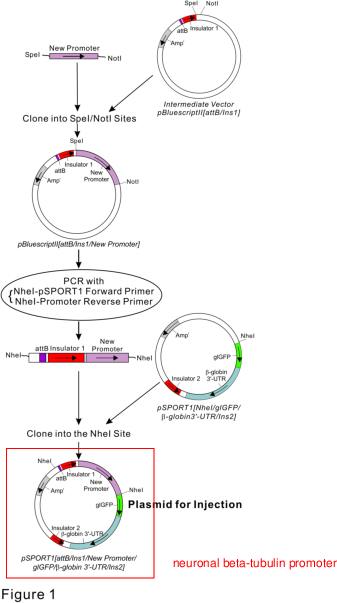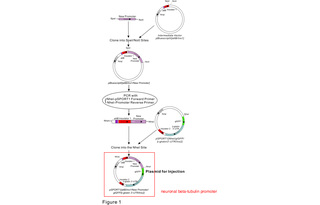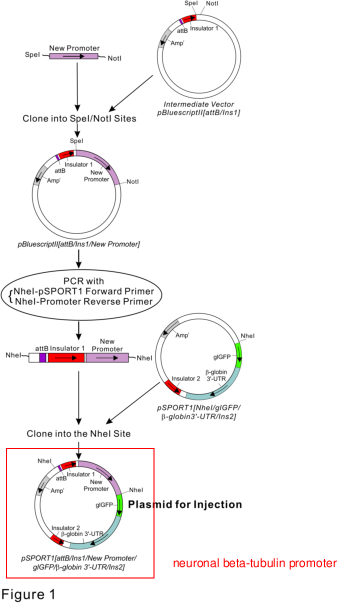pSPORT1[attB/Ins1/NbT promoter/glGFP/bglobin 3'-UTR/Ins2]
(Plasmid
#74102)
-
Purposeplasmid driven under neuronal beta-tubulin promoter, bearing attB and two insulator sequences (opposite directions pointing inward towards the reporter gene)
-
Depositing Lab
-
Sequence Information
Ordering
| Item | Catalog # | Description | Quantity | Price (USD) | |
|---|---|---|---|---|---|
| Plasmid | 74102 | Standard format: Plasmid sent in bacteria as agar stab | 1 | $85 | |
Backbone
-
Vector backbonepSPORT1
-
Backbone manufacturerInvitrogen
- Backbone size w/o insert (bp) 4110
-
Vector typeBacterial Expression
Growth in Bacteria
-
Bacterial Resistance(s)Ampicillin, 100 μg/mL
-
Growth Temperature37°C
-
Growth Strain(s)DH5alpha
-
Copy numberHigh Copy
Gene/Insert 1
-
Gene/Insert nameXenopus laevis beta-tubulin gene promoter region and 5'UTR
-
SpeciesX. laevis (frog)
-
Insert Size (bp)3800
-
GenBank IDEF989124
Gene/Insert 2
-
Gene/Insert nameGreen Lantern Green Fluorescent Protein
-
Insert Size (bp)730
Gene/Insert 3
-
Gene/Insert nameRabbit beta 1-globin gene 3'UTR
-
SpeciesO. cuniculus
-
Insert Size (bp)2184
Resource Information
-
A portion of this plasmid was derived from a plasmid made byPurchased as pGreenLantern from GIBCO BRL
Terms and Licenses
-
Academic/Nonprofit Terms
-
Industry Terms
- Not Available to Industry
Trademarks:
- Zeocin® is an InvivoGen trademark.
These plasmids were created by your colleagues. Please acknowledge the Principal Investigator, cite the article in which the plasmids were described, and include Addgene in the Materials and Methods of your future publications.
-
For your Materials & Methods section:
pSPORT1[attB/Ins1/NbT promoter/glGFP/bglobin 3'-UTR/Ins2] was a gift from Ben Szaro (Addgene plasmid # 74102 ; http://n2t.net/addgene:74102 ; RRID:Addgene_74102) -
For your References section:
A method for using direct injection of plasmid DNA to study cis-regulatory element activity in F0 Xenopus embryos and tadpoles. Wang C, Szaro BG. Dev Biol. 2015 Feb 1;398(1):11-23. doi: 10.1016/j.ydbio.2014.11.010. Epub 2014 Nov 20. 10.1016/j.ydbio.2014.11.010 PubMed 25448690





